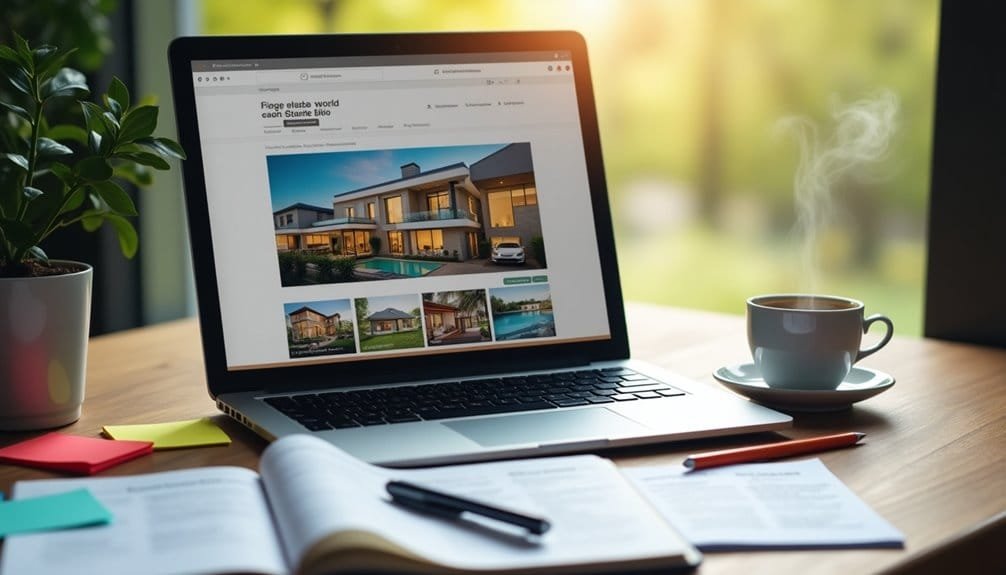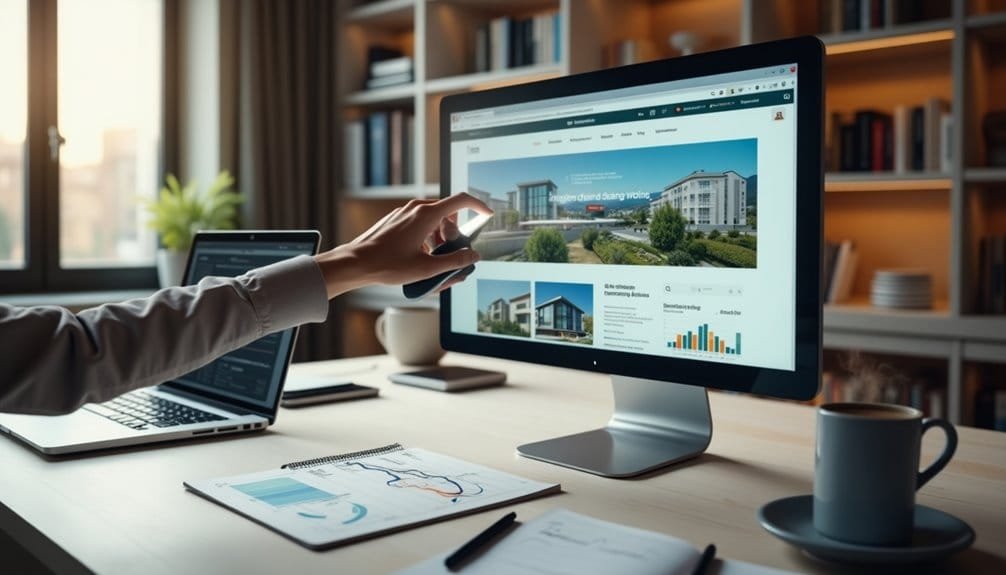To build a real estate blog that boosts your SEO, start with thorough keyword research using tools like Google Keyword Planner. Target location-specific, long-tail keywords to attract local traffic and reduce competition. Craft engaging content, focusing on evergreen topics, and incorporate multimedia elements to enhance readability. Optimize your blog with on-page SEO techniques such as well-structured headers, intriguing meta descriptions, and high-quality images. Promote your content through social media and collaborations with local businesses. Regularly update your blog to maintain relevance and fast loading times, ensuring it’s mobile-friendly. As you explore further, you’ll discover strategies to enhance your online presence.
Key Takeaways
- Conduct thorough keyword research focusing on high-volume, low-competition, and location-specific keywords for targeted traffic.
- Create evergreen and localized content that addresses market trends and community highlights to engage readers.
- Optimize on-page SEO elements, including titles, meta descriptions, and headers, for better search engine visibility.
- Use multimedia formats like photos and videos to enhance engagement and improve user experience.
- Collaborate with local businesses and participate in community events for expanded reach and increased backlinks.
Keyword Research Strategies

When building a real estate blog, mastering keyword research strategies is vital to driving traffic and attracting the right audience. Start by using tools like Google Keyword Planner, SEMrush, and Ahrefs to find high-volume, low-competition keywords. This step is significant because it helps you focus on location-specific and long-tail keywords, such as “homes for sale in Chelmsford, MA,” which are more likely to connect with potential buyers in your target area. Incorporate local keywords to attract geographically targeted traffic and enhance local visibility. Analyzing competitors’ keywords will also highlight gaps and opportunities you can capitalize on, giving you a competitive edge. By focusing on long-tail keywords, you can significantly improve your chances of ranking higher on search engines, as they often face less competition than broader terms.
Understanding search intent is another key element. Recognize whether your audience is seeking information, exploring specific sites, or ready to make a transaction. Tailor your content to match these intents using intent-based keywords, ensuring you attract qualified leads.
Long-tail keyword strategies enhance this approach by targeting phrases with at least three words, helping you focus on niche areas and reduce competition.
Crafting Compelling Content
Crafting compelling content is all about honing in on what keeps your audience engaged and coming back for more. Start by focusing on evergreen topics that maintain their relevance over time, ensuring a steady flow of visitors.
Immerse yourself in educational content, offering insights into buying, selling, and maintaining property. This not only boosts your website traffic but also builds credibility by showcasing your expertise and recent successes.
To create engaging content, tailor your posts to specific neighborhoods, providing detailed insights into community amenities and lifestyles. Consider publishing sustainable living guides to attract eco-conscious buyers. With 60% of buyers prioritizing neighborhood quality, emphasizing local businesses and amenities is crucial.
Incorporate multimedia formats like high-quality photos, interactive maps, and videos to enhance engagement. Diversify your content formats with lists, guides, and infographics, appealing to different audience segments.
Use lead magnets like downloadable guides or eBooks to generate sales leads and syndicate your content across platforms like Medium for broader exposure. Share success stories to build trust, and encourage readers to comment, share, or follow on social media.
Collaborate with local businesses for community-focused content, fostering online relationships and delivering value to your readers. Regular blogging builds brand authority, enhancing your credibility in the real estate market. Prioritize user experience, making it easy for visitors to subscribe and stay engaged.
On-Page SEO Techniques

To guarantee your compelling content reaches a wider audience, you must harness on-page SEO techniques effectively. Start with thorough keyword research using tools like Google Keyword Planner, SEMrush, and Ahrefs to pinpoint high-volume, low-competition keywords. Focus on niche keywords related to real estate, such as “luxury homes for sale in [city]”, and incorporate long-tail keywords like “condos for sale in [city]” to attract more qualified leads. Given the fact that 78% of property searches initiate on search engines, primarily Google, it’s critical to optimize your website for higher visibility. Optimize on-page elements by naturally integrating these keywords into titles, meta descriptions, headers, and URLs, making certain search engines understand your content without falling into the trap of keyword stuffing. Additionally, leveraging tools like Canva can help create visually appealing graphics to enhance your blog posts.
Structuring your content is essential. Create content hubs centered around seed keywords to establish authority with Google. Use header tags (H1, H2, H3) to organize your content logically, making it easy to read and comprehend while embedding secondary keywords. It’s important to note that SEO operates continuously, generating leads even outside business hours, which underscores the value of maintaining an optimized real estate blog.
Craft compelling meta titles and descriptions that include primary keywords to capture readers’ attention. Enhance your posts with high-quality images, using descriptive alt text to boost SEO and accessibility.
Enhancing Technical SEO
Optimizing your real estate blog’s technical SEO involves several key strategies that can greatly impact its performance and visibility.
Start by making sure your website loads quickly to keep visitors engaged and reduce bounce rates. You can achieve this by optimizing images to minimize file sizes, combining files to reduce HTTP requests, and using a content delivery network (CDN) to spread the server load efficiently. Keeping your plugins and themes updated is vital in preventing potential speed issues.
Next, focus on mobile and voice search optimization. A responsive design is essential to provide a seamless experience across devices, and optimizing for voice search can help you capture traffic from voice-assisted queries. It’s important to prioritize mobile-first indexing, aligning with Google’s preferences, and testing for mobile usability issues to guarantee smooth navigation. Since real estate SEO is crucial for attracting organic traffic, ensuring your blog is optimized for both desktop and mobile users can significantly improve your search engine rankings. Google holds 88.83% of the U.S. search market share, making it imperative to align your SEO strategies with their guidelines to maximize visibility.
Incorporating schema markup can further enhance search engine understanding of your content.
Lastly, conduct regular technical audits to maintain your website’s health. This includes checking for broken links, implementing SSL certification for security, and updating your sitemap and robots.txt file.
Address any duplicate content issues and monitor for negative SEO activities to safeguard your blog’s reputation.
Effective Promotion Tactics

Promotion is often a critical component of your real estate blog’s success, and employing effective tactics can greatly boost your reach and engagement. Start by leveraging social media platforms to share your blog posts widely, targeting potential buyers and sellers in your area. Use enchanting visuals and compelling headlines to draw attention. Engage with your audience by encouraging comments and discussions, demonstrating your expertise in the real estate field. Utilizing social media scheduling tools can help streamline your posting process and ensure consistent engagement.
Collaborate with other local businesses or influencers to expand your reach. Guest blogging on relevant sites can increase your blog’s visibility and attract new readers. It’s also beneficial to participate in community events and sponsor local activities, which can enhance your brand’s presence and build trust within your community. Optimizing your blog with location-specific keywords is crucial for capturing local client attention, ensuring that your content resonates with the local market dynamics. Utilizing specific keywords relevant to home buyers can significantly improve your blog’s search engine rankings and visibility.
Email marketing remains a powerful tool for promotion. Regularly send newsletters featuring your latest blog posts, market insights, and practical tips to your subscriber list. This keeps your audience engaged and informed.
Utilize SEO strategies, like optimizing meta descriptions and utilizing long-tail keywords, to guarantee your blog is easily discoverable in search engines. By integrating these promotional tactics, you can effectively increase your real estate blog’s visibility and drive meaningful engagement.
Local SEO Methods
Many real estate blogs struggle to gain visibility in their local markets, but effective local SEO methods can change that. Start by refining your website to attract local searches. Incorporate local keywords naturally into your content using tools like Google Keyword Planner and SEMrush to find high-performing terms.
Make sure your Name, Address, and Phone Number (NAP) are consistent across all local directories and your website. Given that most searches occur on mobile devices, optimize your site for mobile by employing responsive design to enhance user experience.
Creating localized content is essential. Engage your audience by writing about local market trends, community events, and real estate topics. Consider crafting neighborhood guides and market reports to showcase your expertise.
Incorporate local keywords seamlessly into blog posts and property descriptions. Video content, such as virtual property tours and area highlights, can also capture attention.
Building local citations and backlinks strengthens your online presence. List your business in local directories, ensuring NAP consistency. Collaborate with local brands for guest posts and reputable backlinks.
Share local content on social media and build relationships with local businesses to enhance your backlink profile, increasing visibility and credibility in the local market.
Monitoring and Updating Strategies

After implementing local SEO methods to enhance your blog’s visibility, it’s time to confirm those efforts are consistently effective through monitoring and updating strategies. Regularly auditing your website is essential for maintaining its performance. Not only does this help you identify areas for improvement, but it also guarantees your site remains competitive in the real estate market.
You should prioritize tasks like checking your website speed to ascertain it loads in under 3 seconds—this enhances user experience and reduces bounce rates.
Moreover, keeping your content fresh is vital. Regular updates are necessary because 60% of top 10 Google results include outdated content. By consistently improving your blog posts, you’re more likely to maintain or improve your search rankings.
Here are some strategies you should follow:
- Monitor website speed: Quick load times keep visitors engaged.
- Analyze mobile-friendliness: Confirm accessibility on all devices.
- Track organic traffic: Measure the effectiveness of your SEO efforts.
- Update content regularly: Keep your blog posts current and relevant.
Implementing these strategies will help you maintain a robust online presence, confirming your real estate blog remains a valuable resource for your audience.
- Prepare for Loan Maturities and Refinancing Waves as a Real Estate AgentIn mastering loan maturities and refinancing waves, uncover strategies every real estate agent needs to empower clients during pivotal financial transitions.
Frequently Asked Questions
What Is the Ideal Posting Frequency for a Real Estate Blog?
You should aim to post on your real estate blog 1-2 times a week. This frequency helps maintain reader interest without overwhelming your audience.
Focus on delivering high-quality, informative content that addresses common real estate questions or offers market insights. Consistency is key, so choose a schedule you can maintain.
Use engaging visuals and real-life examples to enhance your posts, and always encourage reader interaction through comments or social media.
Recent Posts

Video Marketing Tools for Real Estate: A Comprehensive Guide

What Does Coldwell Banker Offer Agents

Best Lead Generation Strategies for Real Estate Agents in 2025
How Can I Measure the Success of My Real Estate Blog?
You can measure your real estate blog’s success by tracking page views to see visitor numbers and engagement metrics like likes, comments, and shares that indicate content quality.
Monitor the bounce rate to assess engagement; a higher rate means less engaging content.
Check lead generation and conversion rates to evaluate effectiveness in attracting business.
Additionally, watch keyword rankings, organic traffic, and backlinks to measure SEO performance, ensuring your blog remains competitive and authoritative.
Should I Hire a Professional Writer for My Real Estate Blog?
You should consider hiring a professional writer for your real estate blog because they bring quality and expertise to your content.
They understand SEO techniques, ensuring your blog reaches a larger audience. Professional writers conduct thorough keyword research, crafting content that resonates with your target audience.
They maintain consistency and update content regularly, essential for boosting SEO. While there are costs involved, the potential increase in website traffic and engagement can justify the investment.
How Do I Choose the Right Blogging Platform for Real Estate?
To choose the right blogging platform for real estate, focus on features that enhance your content strategy.
Make certain it offers a user-friendly interface for easy updates, customization options to match your brand, and built-in SEO tools for improved visibility.
Prioritize platforms with mobile optimization and seamless integration with plugins.
Consider the platform’s scalability, security, and cost-effectiveness.
Reliable customer support is essential for resolving issues quickly, making sure your blog operates smoothly and effectively.
What Is the Best Way to Monetize a Real Estate Blog?
To monetize your real estate blog, focus on affiliate marketing, sponsored posts, advertising revenue, and lead generation.
Collaborate with real estate companies for affiliate links and promote relevant products. Partner for sponsored content, ensuring transparency.
Use Google AdSense for ad revenue, strategically placing ads.
Generate leads by offering valuable content like e-books or webinars. Integrate lead capture forms in your content, transforming visitors into potential clients and boosting your blog’s income.
Bottom Line
By implementing these strategies, you’ll create a robust real estate blog that greatly boosts SEO. Start with thorough keyword research to target your audience effectively, then craft compelling content that resonates with readers. Utilize on-page and technical SEO techniques to enhance visibility. Promote your blog actively and employ local SEO methods to connect with nearby clients. Finally, regularly monitor your progress and update your content to maintain relevance, ensuring your blog remains an essential asset in your digital marketing toolkit.






